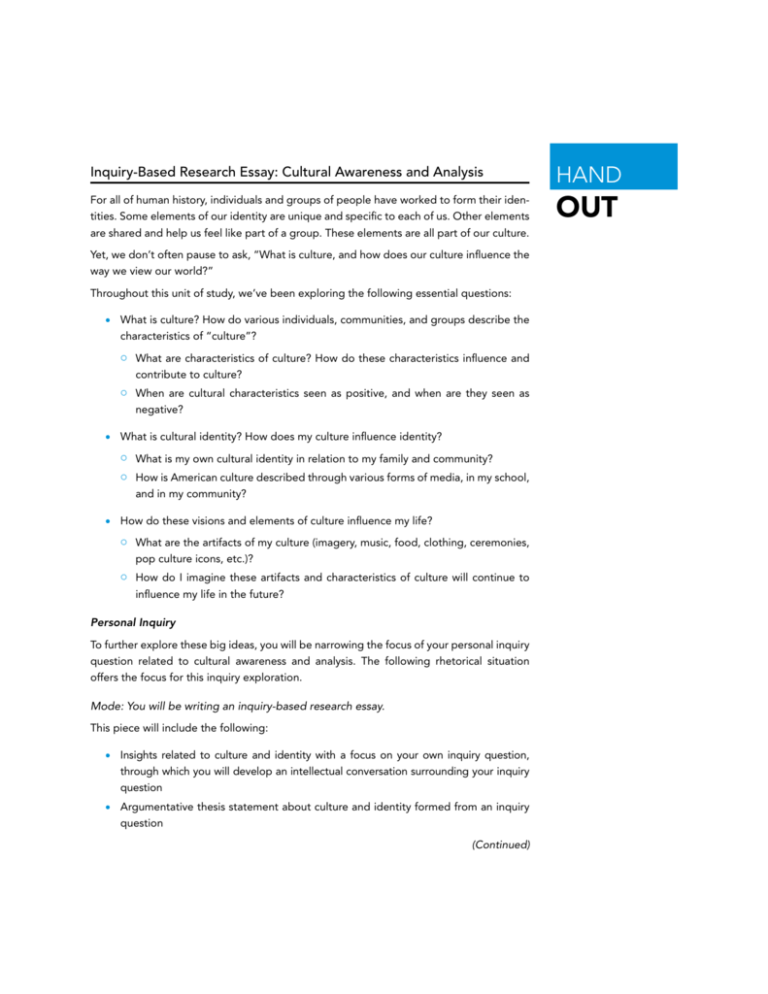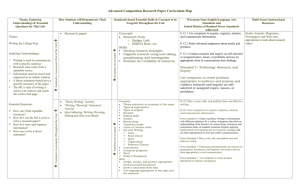
Inquiry-Based Research Essay: Cultural Awareness and Analysis
HAND
For all of human history, individuals and groups of people have worked to form their identities. Some elements of our identity are unique and specific to each of us. Other elements
are shared and help us feel like part of a group. These elements are all part of our culture.
OUT
Yet, we don’t often pause to ask, “What is culture, and how does our culture influence the
way we view our world?”
Throughout this unit of study, we’ve been exploring the following essential questions:
•• What is culture? How do various individuals, communities, and groups describe the
characteristics of “culture”?
{{
What are characteristics of culture? How do these characteristics influence and
contribute to culture?
{{
When are cultural characteristics seen as positive, and when are they seen as
negative?
•• What is cultural identity? How does my culture influence identity?
{{
What is my own cultural identity in relation to my family and community?
{{
How is American culture described through various forms of media, in my school,
and in my community?
•• How do these visions and elements of culture influence my life?
{{
What are the artifacts of my culture (imagery, music, food, clothing, ceremonies,
pop culture icons, etc.)?
{{
How do I imagine these artifacts and characteristics of culture will continue to
influence my life in the future?
Personal Inquiry
To further explore these big ideas, you will be narrowing the focus of your personal inquiry
question related to cultural awareness and analysis. The following rhetorical situation
offers the focus for this inquiry exploration.
Mode: You will be writing an inquiry-based research essay.
This piece will include the following:
•• Insights related to culture and identity with a focus on your own inquiry question,
through which you will develop an intellectual conversation surrounding your inquiry
question
•• Argumentative thesis statement about culture and identity formed from an inquiry
question
(Continued)
(Continued)
•• Clear subclaims used to support the thesis statement
•• Evidence from multiple sources used as part of the support of subclaims and ultimately the thesis statement
•• Warrants used to explain how the evidence supports the claims
You will need to use a variety of evidence in support of your claims. You need to have enough
sources to back up your argument. At a minimum, use your literature circle book and three other
texts (including various media and print texts). Include your own original research, as well as several primary and secondary sources to support your ideas. You can use sources we’ve explored,
but you’ll also need to do your own research to find other sources to support your ideas too.
Your Original Research
Primary Sources
We’ve Explored
Secondary Sources
We’ve Explored
•• Your own surveys
and interviews
•• TED Talks or
commercials
•• Your original
blog posts
•• Data sets
•• Articles and
presentations that
analyze or report
on existing data
•• Your culture collage
•• Literature circle book
•• Book reviews
Media: You will be writing a print-based text.
You can turn in your work in either print form or through Google Drive.
Audience: You are writing this piece for a variety of audiences.
Your audience includes the following:
•• You
•• Teacher
•• Your primary audience (identified by you and based on your topic), which may include Youth Voices, our online class space, readers of a magazine, or an audience
that might be exploring similar questions in various professional learning networks
(both digital and print-based)
•• Other potential readers that you invite to read your work, such as family members
and friends
Purpose: You also have a variety of purposes for your work.
Your purposes include
•• Examine your own thinking about your inquiry question and the unit essential questions
•• Engage in real-life and real-world questions that interest you and relate to your life
(Continued)
(Continued)
•• Analyze literature, including fiction, nonfiction, and other research
•• Explore your own original research, as well as primary and secondary research
•• Practice argumentative writing skills
•• Delve into research and synthesis for analysis
•• Consider a variety of evidence to support your ideas
•• Hone research, analysis, and synthesis skills
•• Develop a debatable and defensible claim to address your inquiry question
•• Add to the intellectual conversation surrounding your topic by engaging with an
audience that is invested in your question
•• Understand that because you are a researcher, your writing fits into a larger
intellectual conversation
For this piece, you need to think about how your audience and purpose are related.
Situation: As part of your work, you should consider the following situations.
Writing: A successful inquiry-based research essay will
•• Pay homage to essential questions about culture and identity
•• Tease out some characteristics of culture, using artifacts as examples
•• Embrace an audience and purpose relevant to your topic and beyond just your teacher
•• Be long enough to develop your argument with adequate support and evidence
(at least 3 pages)
•• Cite resources according to guidelines from your teacher with both in-text and
works cited lists
Writer: As a writer, be the best you can be. Plan ahead and stay on top of deadlines.
Brainstorm for peer response due
Introductory paragraph for peer response due
Body paragraph for peer response due
Body paragraph for peer response due
Draft 1 for peer response due
Draft 2 for peer response due
Final draft turned in to teacher and published
(Continued)
(Continued)
Assessment: Your paper will be evaluated based on the following:
•• Writing addresses the rhetorical situation (on the due date, you will have time to
write a reflection identifying your rhetorical situation and reflecting on your work).
{{
Writing is shared with an audience identified by the author.
•• Writing includes an argumentative thesis statement about culture and identity
formed from an inquiry question.
{{
Writing includes clear subclaims used to support the thesis statement.
{{
Writing includes evidence from multiple sources as part of the support for subclaims and ultimately the thesis statement.
{{
Writing explains how the evidence supports the thesis statement (warrant).
{{
Writing includes a variety of evidence used in support of your claims. You need
to have enough sources to back up your argument. At a minimum, use your literature circle book and three other texts (including various media and print texts).
Include at least one original research primary source, as well as several other
primary and secondary sources.
•• Writing teases out some characteristics of culture, using artifacts as examples.
•• Writing includes a list of references, including primary and secondary sources as well
as your own original research.
Retrieved from the companion website for Research Writing Rewired: Lessons That Ground Students’ Digital Learning by Dawn
Reed and Troy Hicks. Thousand Oaks, CA: Corwin, www.corwin.com. Copyright © 2016 by Corwin. All rights reserved. Reproduction
authorized only for the local school site or nonprofit organization that has purchased this book.





